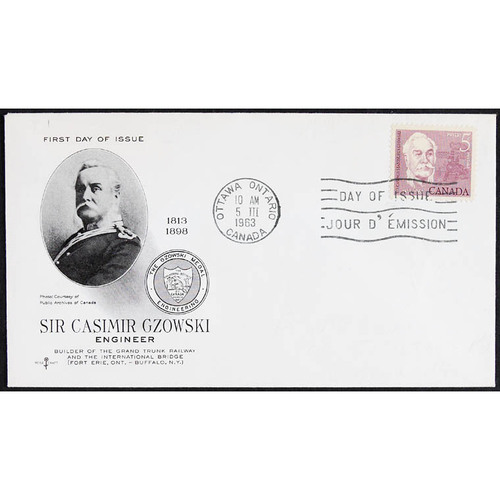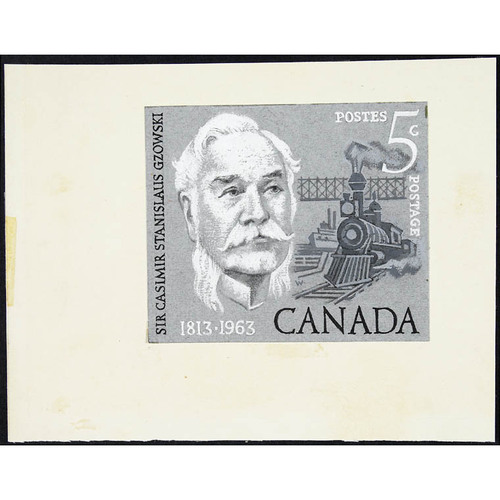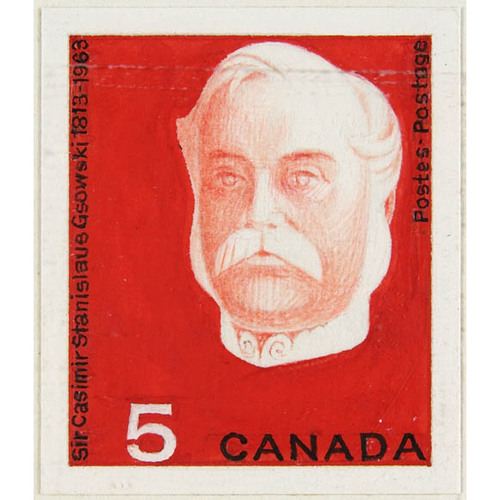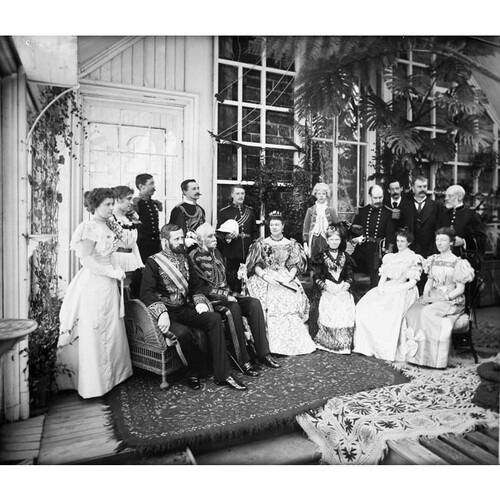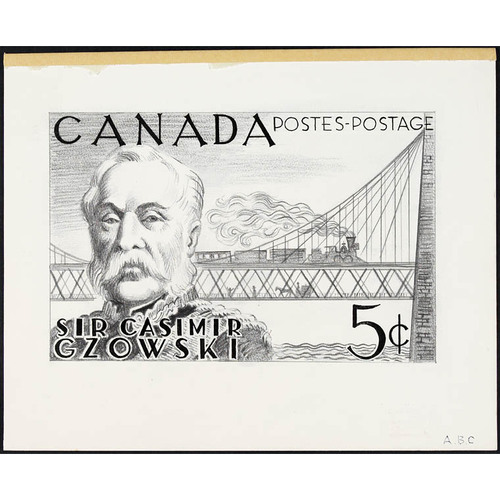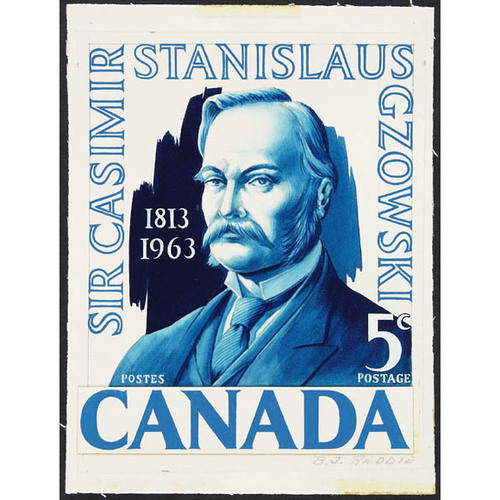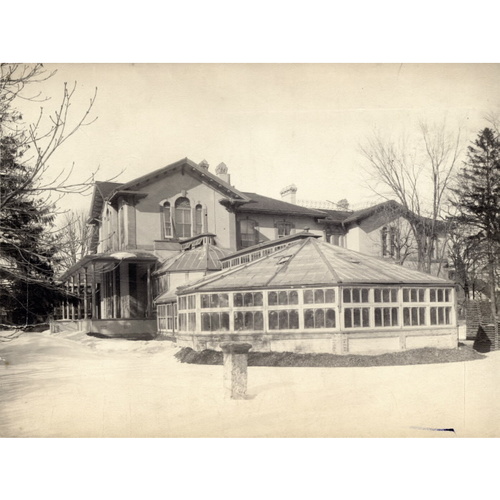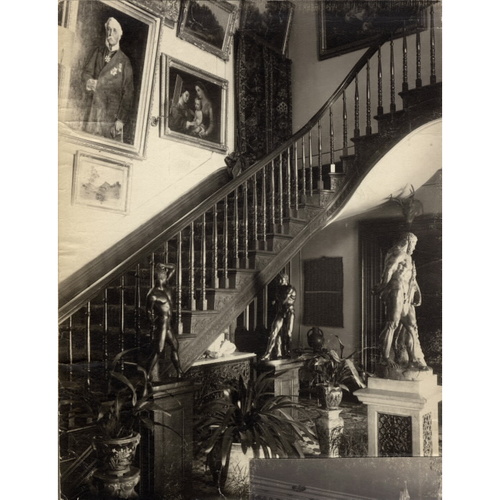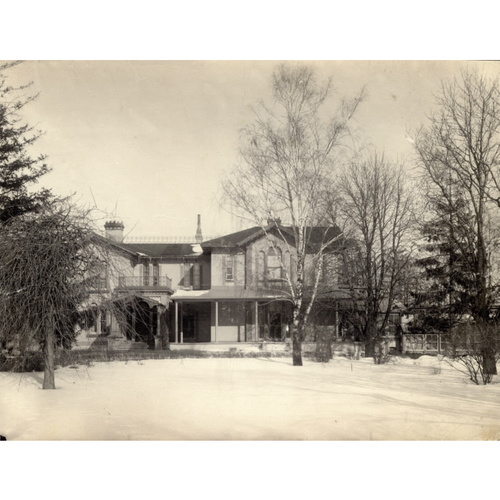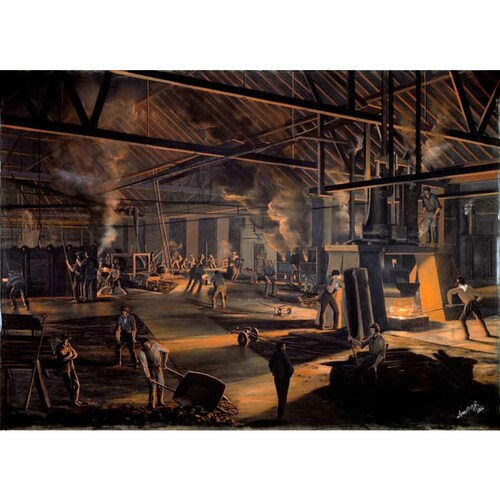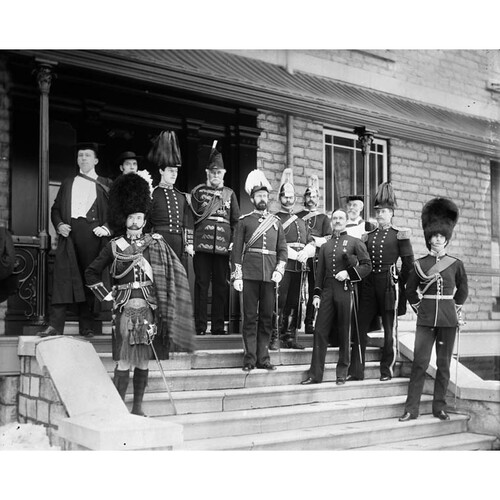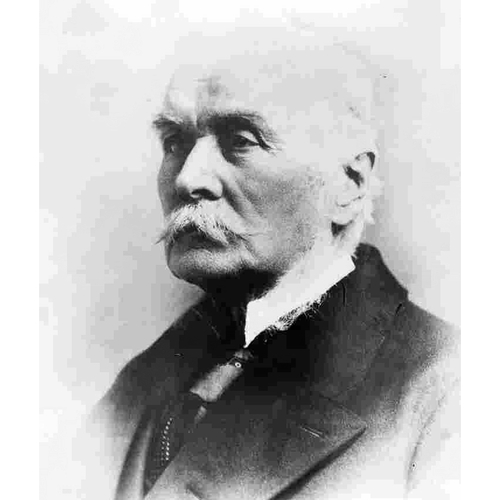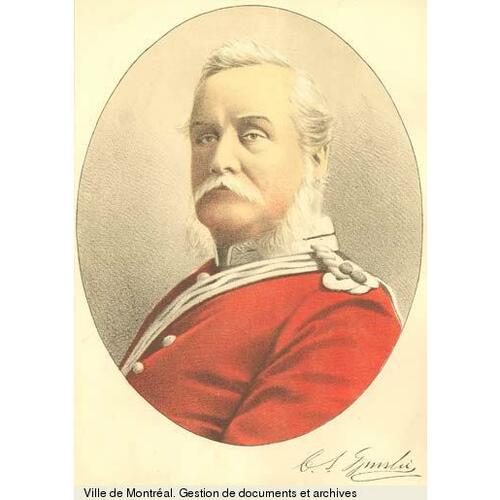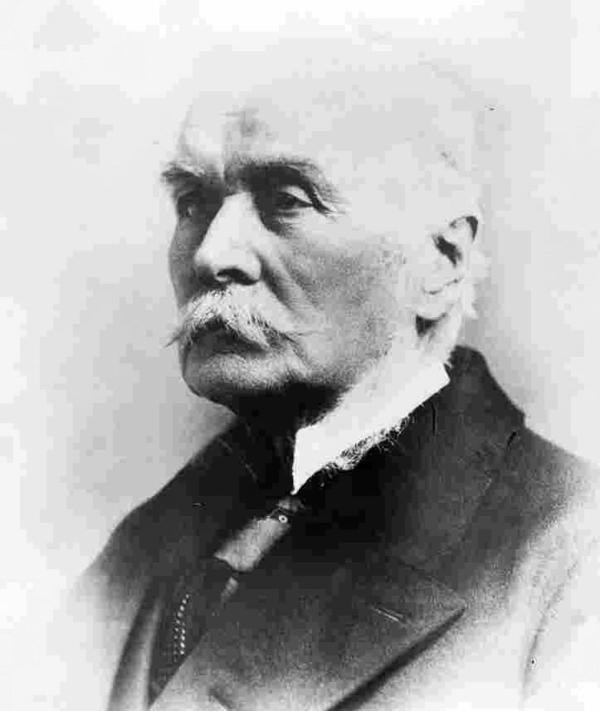
Source: Courtesy of Wikimedia Commons
GZOWSKI, Sir CASIMIR STANISLAUS, engineer, office holder, businessman, militia officer, and patron; b. 5 March 1813 in St Petersburg, Russia, eldest son of Count Stanislaw Gzowski and Helena Pacewicz; m. 29 Oct. 1839 Maria M. Beebe, and they had eight children, six of whom survived infancy; d. 24 Aug. 1898 in Toronto.
Sir Casimir Stanislaus Gzowski fulfilled the late Victorian Canadian yearning for a romantic hero. Most of his life was quite prosaic; some of it verged upon the scandalous. But it began dramatically and ended well, and that is what he would be primarily remembered for.
Gzowski’s father was born into the minor Polish landed nobility in the region of Grodno, and he followed his forebears as a career army officer. In the late 18th century, when Poland was partitioned on three successive occasions by Prussia, Austria, and Russia, the Grodno region was incorporated into Russia and the Roman Catholic Gzowski family accordingly attached itself to the new regime, Count Gzowski obtaining a commission as a captain in the Imperial Guard. Casimir Stanislaus was born in 1813 during a tour of duty by his father in the imperial capital. In the expectation that the eldest son would also follow a military career, he was sent away at the age of nine to a famous preparatory school, the Lyceum of Krzemieniec (Kremenets, U.S.S.R.), in the province of Volhynia, where he followed a rigorous curriculum, combining languages and literature with architecture, medicine, and surveying. Upon his graduation in 1830, Gzowski’s father found him a place, at the age of 17, in the Imperial Corps of Engineers.
In 1815 the Congress of Vienna had recreated a Polish kingdom, Congress Poland, with a progressive constitution, but placed it under Russian suzerainty. Bridling for years under czarist rule, Polish nationalists seized the opportunity presented by the 1830 uprisings in western Europe. In November a conspiracy among Polish officers and civilians in Warsaw broke into open revolt. The city fell with little struggle. Soon a revolutionary régime claimed support throughout the kingdom. Gzowski, and young officers like him, such as Alexandre-Édouard Kierzkowski*, provided the impetus for the nationalist cause which aimed initially at the restoration of constitutional government within the Russian empire, and subsequently at an independent Poland.
The Russian army regrouped and in February 1831 invaded Congress Poland. Gzowski served as an officer in a Polish corps commanded by General Dwerniki, a veteran of campaigns against Napoleon. He was most probably among Dwerniki’s troops when they temporarily halted the Russian army at the battle of Stoczek on 14 February. Nevertheless, a pitched battle before the gates of Warsaw, at which Gzowski was said to have suffered a minor wound, marked the beginning of the end for the outnumbered Polish insurgents. In September the Russians finally captured the city. By this time Gzowski was in an Austrian prison. Dwerniki’s corps, on a diversionary assault to raise a sympathetic rebellion in Volhynia, had been driven across the Austrian frontier on 27 April. Under diplomatic pressure from Russia, the Austrian authorities interned the 4,000 rebel troops, Gzowski among them.
In the mean time the Polish patriotic cause had attracted sympathy throughout the network of Polish exiles abroad and liberal circles in western Europe, Great Britain, and the United States. Sympathy did not convert to military support but public opinion had a decisive bearing upon the fate of Dwerniki’s imprisoned brigade. In relatively benign Austrian hands they became a symbol of the lost cause and a flickering ray of hope for Polish nationalism. Great Britain and France brought diplomatic pressure to bear upon Austria not to turn them over to the Russians. For two years the internees were moved from fort to fort; at each relocation escapes reduced their numbers. At length the Austrian government allowed the remaining prisoners to be transported into permanent exile in the United States, where their revolutionary ideals and subsequent distress had aroused considerable public interest. Accordingly, in November 1833, 264 of them, including Gzowski, were loaded aboard two Austrian frigates for what turned out to be a harrowing, mid-winter crossing. In March 1834 the frigates put into New York harbour, where the bewildered Polish boat-people received an enthusiastic reception. The Austrian consul gave each man $50, American philanthropists provided additional support, theatrical and musical benefits were organized, the press publicized the exiles’ plight, and a Polish committee organized itself to look after their long-term welfare and employment.
Alone in America, but not without friends, Gzowski followed a strategy of making the most of his literacy and gentility. While he learned English he gave lessons in music, fencing, and languages. One by one the refugees dispersed as American friends found places for them. Through this network Gzowski secured employment that summer in Pittsfield, Mass., as a clerk in the law office of Parker L. Hall; he continued to support himself teaching French, German, and draftsmanship. Around the office he proved both an exotic ornament and an adept student. Gzowski learned more than English and the rudiments of American law. He closely observed Yankee ways, especially the manner by which successful businessmen conducted their affairs through the careful drafting and enforcement of binding contracts. A secret of his later success was his bringing the skills of a Yankee lawyer to the rough-and-tumble world of Canadian railway contracting.
By November 1837 he had completed his apprenticeship at law, acquired American citizenship, and won the admiration of his seniors. In recommending him, one of Hall’s partners spoke of his “high conduct, gentlemanly deportment,” another of his “good moral character,” and a third praised the “very great attainments he has made . . . in our language, in the knowledge of our institutions and of the law in general.” These testimonials were necessary, for in true American fashion Gzowski had announced that he was “going to move west.” At the age of 24, attended by that irresistible romantic aura that surrounds aristocrats and exiles in America, he made for the booming coal country of western Pennsylvania to hang up his shingle. With his letters of recommendation he quickly gained admission to the Pennsylvania bar and established a practice in the small town of Beaver, on the Ohio River.
Ironically his new situation placed a greater premium upon his previous experience than on his legal credentials. Pennsylvania was alive with internal improvement schemes: roads, bridges, turnpikes, and especially canals. Drawing upon his training as a military engineer, Gzowski made himself useful to William Milnor Roberts, the chief engineer of many of these canals. Working with Roberts on the Beaver and Ohio River Canal, which extended communications northward over the watershed into the Lake Erie district, Gzowski shifted careers from law to engineering and his base of operations from the Ohio to Erie, Pa, where Roberts’s firm maintained its office. Gzowski gained further valuable experience in Roberts’s service locating and building a section of the Erie Railroad through western New York. During his travels the courtly Polish lawyer-turned-engineer met, and in October 1839 married, a doctor’s daughter from Erie, Maria Beebe.
In less than a decade in the United States Gzowski had made remarkable progress. He had mastered commercial law, and had applied his military surveying skills to canals and railways, while he acquired on-the-job experience with American construction methods and the techniques of project management In the autumn of 1841 Roberts dispatched Gzowski across Lake Erie to scout out the possibilities of work in Canada on the reconstruction of the Welland Canal. After a quick tour of inspection, Gzowski submitted a proposal to William Hamilton Merritt*, an mla and the canal’s primary promoter, to rebuild the entire feeder canal from Port Maitland and “to drive the work to completion in one season.” In 1842 Gzowski journeyed to the provincial capital, Kingston, in pursuit of Merritt. There he failed in his effort to win the construction contract, but a chance encounter with Governor Sir Charles Bagot* turned up an even more promising prospect. During the 1820s Bagot had been the British ambassador in St Petersburg, where he had made the acquaintance of Gzowski’s father. Gzowski’s account of the rebellion, his exile, and his remarkable career in the United States captivated the governor, who is said to have declared, “We must keep you in Canada.” Bagot needed men with Gzowski’s skills. Under the act of union the government had undertaken an ambitious program of road and canal construction. He offered and Gzowski accepted the position of superintendent of roads and waterways in the London district of Hamilton Hartley Killaly*’s public works establishment.
In 1842 Gzowski settled his growing family (two daughters born in Erie and a son, Casimir Stanislaus, who lived only two years) in London, the field headquarters from which he supervised the construction of a host of roads, bridges, lighthouses, and harbours throughout the western peninsula. Gzowski studied the contours and capabilities of the thinly settled region with a practised eye as he traversed the countryside, laying down gravel and plank roads between Hamilton and Amherstburg, and building harbours at Port Stanley and Rond Eau (Rondeau Harbour). After 1845 he worked mainly out of Toronto, taking charge of improvements to Yonge Street north to Lake Simcoe, the surveying of numerous colonization roads, and the construction of stone bridges on the trunk-highways. He also gave advice to the proprietors of the Desjardins Canal [see John Paterson*] concerning improvements. During this time Maria gave birth to a third daughter and a boy, also named Casimir Stanislaus after the death of their first-born son.
Government service did not entirely satisfy the restless and ambitious civil engineer, although he was sufficiently pleased with the opportunities offered by the country to take out British citizenship in 1846. With the Board of Works he experienced the challenge of managing large and important projects, but the wealth of the country lay beyond his grasp. Moreover, as jealous, cheese-paring politicians reined in the high-spending, quasi-independent Board of Works in 1846, cut-backs greatly reduced its capital budget and staff and demoralized the remaining personnel. In 1848 Gzowski jumped at the first opportunity to leave, a commission from a Hamilton group, the Upper Canada Mining Company, to examine its Wallace Mine and several other copper properties along the north shore of Lake Huron.
Introduction and passage of the Guarantee Act by the provincial legislature in the spring of 1849 revived a number of dormant railway projects, among them the St Lawrence and Atlantic Rail-road. With the promise of government assistance, in January its leading director, Alexander Tilloch Galt, had hired Gzowski, whose reputation and American railway experience recommended him, as engineer in charge of completing construction through the Eastern Townships to the American border. It was a risky career move. The railway had hung on the lip of bankruptcy for several years; its financing was still far from certain. Nevertheless, the project brought Gzowski back into the most dynamic field of engineering. Moreover, it brought him into a close working relationship with the leading capitalists of Montreal, most notably Galt, Luther Hamilton Holton*, John Young*, and David Lewis Macpherson.
From his new base in Sherbrooke, Lower Canada, Gzowski oversaw expeditious completion of the St Lawrence and Atlantic. By September 1852 he had opened it from Montreal to Sherbrooke. He then surveyed the rest of the line through to Island Pond, Vt, where it would eventually connect with the Atlantic and St Lawrence out of Portland, Maine. Gzowski impressed his Montreal principals with his ability to drive the stalled project forward and build it for less than the £6,500 per mile cost allowance. They in turn were doing nicely for themselves in the cockpit of colonial politics, leading him on to better things. By November, Galt, Holton, and Macpherson had joined Gzowski in forming a contracting firm, C. S. Gzowski and Company.
With the addition of Gzowski’s engineering experience, the Galt group had finally mastered the mysteries of low-cost railway construction and actively cast about for other opportunities. In November 1852 Gzowski and Company won a contract to build the Toronto and Guelph Railway, a promotion controlled primarily by the municipalities through which it was intended to pass and for which Gzowski had conducted a preliminary survey. Amidst controversy that local interests had been given short shrift in the negotiations with “strangers,” the Gzowski partnership succeeded in its bid of £355,600 (or £7,350 per mile) largely by virtue of its supposed influence with the provincial government, Galt’s promise to assist with financing both the railway and associated land-development projects on the market in London, England, and the likelihood that the contractors’ influence would have the railway incorporated into the much-discussed Grand Trunk Railway scheme. With the contract to build the Toronto and Guelph in hand, the group then proceeded to buy up a controlling interest in the railway they were building.
Gzowski brought little capital to the partnership but he did contribute something of inestimable value. Holton confessed to Galt that Gzowski’s “energy, his tact, his thorough knowledge of every detail of his business, combined with a nice sense of humour, render him in my judgement the most desirable associate.” Gzowski was a brilliant project manager and on the Toronto and Guelph assignment he proved his worth. From his previous experience with the Board of Works, Gzowski knew intimately the terrain through which the railway would pass. He recruited a larger than usual engineering department, headed by Walter Shanly, to carry out a detailed survey of the route. Then the project was partitioned into manageable subcontracts, with the amount of work required in each portion precisely specified. Subcontractors were carefully monitored by Shanly’s staff, who submitted detailed reports on work in progress to headquarters on specially printed forms. As a result the builders were able to maintain a control over cost unusual for the time. Holton once complained bitterly during a cash squeeze about the size of the engineering staff; but it was this instrument of effective management that allowed the partnership to build the railway for substantially less than the £7,750 per mile they were paid.
They were making a “very nice sum” out of what Holton called their “safe little Guelph contract” when Galt scored a double financial coup in the spring of 1853 that made the project even more profitable. Simultaneously the Galt group had been playing for much higher stakes, the right to build a transcolonial railway, and up until the remarkable spring of 1853 it had largely been losing.
Railways were the politics of Francis Hincks*, the development-minded inspector general of Canada. He believed it was not enough to apply the leverage of the colony’s credit to the prosecution of railway projects, as had been done under the Guarantee Act; the major projects were too big for colonial capitalists and government together. During the early 1850s Hincks had explored every means of winning British support for the construction of a vast trunk-railway running the length of British North America, first as an imperial public work and then, as the commercial climate improved, as a private business venture. In May 1852 he negotiated a contract with the British firm of Peto, Brassey, Jackson, and Betts to build the Montreal to Toronto section of this Grand Trunk Railway.
Galt, Holton, and Macpherson were primarily interested in profiting from the construction of railways in whatever way possible. In anticipation of a trunk-road of some sort, they had established prior occupancy of the territory west of Montreal by means of charters for a Montreal to Kingston and a Kingston to Toronto railway. This placed them in fierce opposition to Hincks’s declared policy of creating a single trunk-line across the colony under unified British management.
The railway committee of the Legislative Assembly in the fall of 1852 had to choose between Hincks’s policy or a much looser association of existing local railway interests, as advocated by Galt and his associates. In the mean time the Montrealers put on a brave front of organizing themselves and set Gzowski to work finding the most suitable route westward. They made the most of their Montreal base, criticized the policy by which a contractor would be given control of the railway, and promised to build the project for much less than the Britishers had proposed. But in the legislature the tide had turned against the Montreal opportunists. Lured by the expansive dreams of William Mather Jackson, who had come to Canada to nail down the contract, and cajoled nicely into line by Hincks, the members passed the Grand Trunk Railway Bill and at the same time cancelled the charters of the two railways squatting on the route. Galt and company had been checked by old friends.
The Montreal scrappers were not without the means to defend themselves. They quickly amalgamated their Montreal to Kingston and St Lawrence and Atlantic properties. Meanwhile, west of Toronto, where the route of the Grand Trunk remained to be settled, they contrived to make themselves indispensable, or at the very least unavoidable. In March 1853 Galt sailed for England to peddle his Toronto and Guelph bonds and to treat with the masters of the Grand Trunk project. There, amid a spring-like optimism about economic prospects and the possibilities of raising money for the Grand Trunk scheme, he cut the deal of a lifetime with his erstwhile competitors. The British contractors, generous to a fault with other people’s money, bought the St Lawrence and Atlantic for £8,000 per mile and a £75,000 bonus, needless to say a substantial premium. Simultaneously the Grand Trunk bought the Toronto and Guelph, extending the contract of Gzowski and Company with a line to Sarnia on the same terms as the Peto, Brassey contract, namely £8,000 per mile. The Galt group thus withdrew from the Montreal–Toronto competition counting its money, and with an even more lucrative contract to extend the trunk-line westward. The partners made a fortune on their Toronto to Sarnia contract. Walter Shanly, who ought to have known, estimated the net profit at £120,000–140,000, or approximately an eighth of the contract price. Gzowski’s skills were essential to bringing the project in under budget so that there was a surplus left to divide.
But contracting profits were only the beginning. Chances like this did not come often and the partners showed a ruthless determination to make the most of their situation. Railways needed stations, land for sidings, yards, freight sheds, and repair facilities. As a condition of their contract, Gzowski and his friends, who decided where these would be situated, conveniently bought up the required land and resold what was needed to the railway at a handsome mark-up, keeping the rest for themselves. Similarly they acquired land around the depots for speculative purposes. As Holton nicely put it to Galt concerning the assembly of land for a station: “It strikes me, that if rightly managed we ought not only to get what we want for nothing but make a good deal of money besides.” Multiple conflicts of interest smoothed the way. In Sarnia the partnership, aided by its solicitor, John A. Macdonald, used its considerable influence with the provincial government to obtain at very low cost some Ordnance lands at Point Edward on the pretext that these were needed for the railway. The company kept the land and later disposed of it for private purposes.
For judging the propriety of such affairs there was as yet no clear line between the acceptable, the questionable, and the unconscionable. A concept of conflict of interest had slowly begun to develop as the electoral franchise broadened, as private élite interests could be seen to be separate and not necessarily identical with a perceived public interest, and as the political system assumed larger fiscal responsibilities and therefore dispensed enormous private benefits. A good deal of room for argument remained as to how much advantage one might take of privileged information in either a public or a private capacity. Clearly it was felt that Hincks had overstepped the limits of the permissible when it came to be known that he was a shareholder in the Grand Trunk and had made a private profit from the placement of some Toronto municipal bonds in London. In February 1853 Holton privately admitted embarrassment about the negotiations with the Grand Trunk and his land deals; he knew he had probably transgressed, but that did not stop him from taking all he could get when the chance arose. Gzowski and his colleagues prospered by virtue of their combined influence with the provincial government and the Grand Trunk; they speculated in land, trading upon privileged information for their private benefit, and they wore their consciences lightly. The scramble for wealth was not for the faint of heart, the hesitant, or those overburdened with scruples.
Gzowski and his partners met their match, however, in the form of the suspicious, combative, and ultimately punitive Toronto municipal council. Early in the 1850s Toronto had attempted to take advantage of the railway construction boom to have all of the transportation projects converge on a centralized facility running the entire length of the city’s waterfront. The provincial government had conveyed some water-lots to the city on the proviso that an extensive esplanade be built. Legislation was passed by the province on 14 June 1853 authorizing debentures, plans were drawn up by Walter Shanly, and in January 1854 Gzowski and Company won the contract to build the esplanade, though its tender was not the lowest. The contractors guaranteed that, in addition to building the esplanade for £150,000 and six bridges for £10,000, they would use their influence to ensure that the Grand Trunk would enter the city along the esplanade.
Shortly after the contract had been let the trouble began. Some of the private water-lot owners resisted the expenses being forced upon them by the project. Worry arose that the contractors were betraying the interests of the city in countenancing delays in the extension of the Toronto and Guelph project westward. The entire contract became embroiled in suspicions that Gzowski and his associates had attempted to gull the city out of its valuable Toronto and Guelph shares before the Grand Trunk takeover and that they had obtained the esplanade contract by improper means and at inflated prices. Furthermore, there was some ambiguity about whether the £10,000 for bridgework was included in the overall contract price or was additional, which Gzowski and Company attempted to exploit. In short, the partners’ reputation had begun to catch up with them; they could no longer be trusted. Dissident elements on the council grew to a majority in 1855, and following an extensive committee examination of the esplanade negotiations the council unilaterally cancelled its contract with the Gzowski firm. The project came to a grinding halt, never to be revived. Gzowski and his associates, finding themselves in an unaccustomed role as the wronged party, began a long campaign to recover costs. Ironically, in 1889 Gzowski and Shanly, this time in the guise of distinguished consulting engineers, were retained by the city to devise a plan to cope with the failure of the project and the consequent confusion over the location of rail lines.
The esplanade was the only failure of Gzowski and Company. But it was enough to chasten the aggressive team. Galt and Holton, fearing their business reputation might affect their political careers, had the partnership wound up in 1857 and the profits divided in 1858. Macpherson and Gzowski carried on in the contracting business under the name Gzowski and Company, operating from Toronto offices in the fashionable Romain Building at the corner of King and Bay streets. They built some Grand Trunk branch-lines in the southwestern part of the province, and a loop-line from Port Huron, Mich., to Detroit. Gradually they began to diversify into real-estate investment and industrial promotion. In association with Theodore and Robert Pomeroy, woollen manufacturers from Pittsfield and friends of Gzowski, they built the Toronto Rolling Mills on three acres near the mouth of the Don River during the late 1850s. On the strength of a ten-year contract (entered into in November 1859) to reroll damaged iron rails for the Grand Trunk, this firm quickly became one of the largest industrial enterprises in the province, employing more than 150 men at the height of its business in the mid 1860s. William Armstrong’s 1864 painting of the mills provides a striking interior view of these early works. Guided by the Pomeroy brothers, Gzowski and Macpherson also invested in the Toronto Whale Oil Plant, which supplied lubricants and illuminating oils to the Grand Trunk. Their projected Toronto Cotton Mills seems not to have got off the ground, but they did successfully promote a sawmilling company in the northern part of the province. The two partners were members of a syndicate that in 1864 bought the Rossin House, Toronto’s finest hotel [see William Cameron Chewett]. Macpherson speculated heavily in Toronto real estate, Gzowski less so and primarily to acquire properties for his own use.
With wealth and success came the conspicuous trappings. In 1855 Gzowski had begun assembling property on Bathurst Street upon which, in the late 1850s, he commissioned Frederic William Cumberland* to construct an Italianate villa in a park-like setting. A close inspection by Toronto’s assessor in 1867 gives a summary of this lavish establishment, known as The Hall. The two-storey brick house of “1st class Extra” quality was flanked by conservatories and surrounded by a six-and-a-quarter-acre lot variously described as a garden, lawn, and deer park. A vinery, greenhouse, stables for five horses and a cow, and a lodge occupied by a coachman and his family adorned the property. The household also contained a dog, a live-in groom, and a gardener, who with his eight-member family and two hogs occupied another Gzowski house on High Street. In 1867 Gzowski’s personal income was rated for tax purposes at $10,000 and his Bathurst Street estate was assessed at $33,282.
In mid-Victorian splendour, surrounded by bric-à-brac, statuary, potted plants, heavy draperies, and walls cluttered with pictures, Gzowski presided over a family which consisted of his wife, three daughters, and three sons. A fourth son, born in 1859, had died in infancy. Each daughter married a British army officer during the 1860s, a sign perhaps that the family’s ambitions survived the descent into trade. The eldest son, however, became a stockbroker; another son was commissioned in the British army and the third died before he could make much of a career in banking.
By the end of the 1860s Gzowski had managed to shed the buccaneering image that had caused him so much trouble in the previous decade. Age, wealth, an estate, a dignified bearing, and a full mane of white whiskers took the edges off his driving ambition. The Gzowskis, now staunch Anglicans and splendid hosts, had entered the highest ranks of Toronto society. The assessment rolls record this ascent as Gzowski’s stated occupation changes from engineer to contractor to gentleman. Over the years The Hall with its spacious grounds, was the scene of many of Toronto’s most memorable garden parties.
Gzowski dreamed briefly in 1867 of reviving the old contracting partnership to build the transcontinental railway. As he explained jokingly and somewhat disjointedly to Galt that year: “You will be the leader keeping sharp look out for good things and do Generals tactics, & Mac[pherson] on the neigh side labour[ing] ong the Political (now made independent of particular elections) ‘altesse’ with his eye steady to the main chance and now and then performing a little practical and useful lobbying for the Trio. Your humble servant will be the off horse and do the grubbing and digging – Holton’s principle of division of labour will work admirably well.” Galt and Holton declined the invitation; they were too tangled up in the politics of the new nation. But Macpherson was still interested. When the chance came a few years later to build the Pacific railway, Gzowski was one of the leading participants in his unsuccessful Interoceanic Railway proposal.
An important challenge in 1870 drew Gzowski and Macpherson back into the contracting business for one last triumph: a railway bridge across the Niagara River linking Fort Erie and Buffalo. The depth and strength of the current at that point, highly unpredictable water-level variations and ice conditions at the end of a large shallow lake, and a treacherous river bottom combined to make this an extremely difficult project. After many harrowing accidents during the construction of the stout masonry piers, the 3,651-foot bridge was opened on 27 Oct. 1873. At the dedication Charles John Brydges*, general manager of the Grand Trunk, declared: “There is no other man in this country who could have carried on the work of this bridge or gone through the daily and hourly anxiety which it entailed during the past four years save Colonel Gzowski.”
Brydges’s compliment to the “Colonel” indicates that Gzowksi had resumed his interest in military matters. In 1864 the suggestion that the British should withdraw some of the troops sent to British North America following the Trent scare in 1861 [see Sir Charles Hastings Doyle*] prompted Gzowski and a committee of concerned citizens to organize a polite but determined protest meeting. Indeed he corresponded privately with public figures urging that the garrison and fortifications of Toronto be strengthened, even submitting draft plans of his own for the defence of Montreal. The Fenian invasions of 1866 [see John O’Neill*] once again threw Gzowski into action; petitions were drafted calling for a stronger British military presence. He served as treasurer for the Battle of Ridgeway Memorial at Queen’s Park in Toronto.
Later in the decade Gzowski was instrumental in organizing the Dominion Rifle Association. This paramilitary federation of militiamen had as its goal the maintenance of a well-trained, civilian armed force throughout the British empire, ready in the case of emergencies. It was also a sporting association, funded largely by the Department of Militia and Defence, which annually sent a contingent to an imperial shooting competition at Wimbledon (London). For a month each summer at the shoot, military men, marksmen, and distinguished patrons such as Gzowski mingled and dined with the British aristocracy and the royal family. In the Canadian national competitions, marksmen of the association vied for the Gzowski Cup. Recognizing his contribution to Canadian defence and his work with the rifle association, and “to give him a military position among those he meets on those associations,” Governor General Lord Dufferin [Blackwood*] had Gzowski commissioned as a lieutenant-colonel of the militia in April 1873.
As he rose in society Gzowski firmly resisted the blandishments of politics. Unlike his former partners, all of whom had tried their hand with varying degrees of success, and even some of his erstwhile engineering colleagues, such as Walter and Francis* Shanly, Gzowski stood resolutely on the sidelines. He brushed aside John A. Macdonald’s offer of the Toronto West riding in 1867 because, as he explained to Galt: “I know you will agree with me that the true place for the off horse is outside of the political stable.”
But it was a delicate business; one could not renounce politics entirely for it alone was the font of formal honours. And as he aged Gzowski craved them. Nor could he escape political obligations completely. Macdonald roped him into a royal commission on canals, partly against his will, in 1870 because the prime minister knew that Gzowski would exercise tact and discretion. In 1872 Gzowski helped Macdonald again, this time by organizing and serving as a trustee for a $66,576 trust fund to provide the prime minister with a dignified, regular income commensurate with his position. Privately he was a fierce Conservative partisan, a substantial personal supporter in 1878 of Macdonald’s electoral fight against what Gzowski called the “Philistines.” But publicly he was above politics. He served too when the Liberal provincial government of Oliver Mowat* came calling with worthy tasks such as chairing the Niagara Falls Park Commission, which he did from 1885 to 1893. For a brief period in 1896–97 he filled in as administrator of the province of Ontario when it was without a lieutenant governor.
Eventually the honours came. Having entertained numerous governors general at The Hall and privately taken responsibility for the prime minister’s welfare, Gzowski was thrilled in 1879, after Sir John had returned to power, to be named honorary aide-de-camp to Queen Victoria. The sinecure allowed him the privileges of wearing a striking court uniform and attending an annual reception at Windsor Castle. It also required his promotion to colonel, in 1882, to give “due honour to Her Majesty.” On the recommendation of both Mowat and Macdonald, Gzowski was made a kcmg in 1890. Thus at the age of 77 he was again a knight, in the service of another empire.
Such a dignified gentleman of ample means, with a romantic past, a great urban seat, excellent political connections, military associates, and aristocratic friends, was much in demand as a patron of worthy causes. Gzowski was an ardent imperial federationist, an avid patron of the arts and music, and active along with other prominent laymen, including the Blakes, in organizing in 1877 the Protestant Episcopal Divinity School (later Wycliffe College), a low-church Anglican theological college [see James Paterson Sheraton*]. He served on the senate of the University of Toronto (1873–93) and in 1881 was appointed by the Adjutant General’s Office to the Board of Visitors to review activities at the Royal Military College of Canada [see Edward Osborne Hewett].
Late in life the stately soldier, engineer, businessman, and gentleman assumed symbolic roles. When the Canadian Society of Civil Engineers was organized in 1887 to enhance its members’ professional status, Gzowski, whom the engineers considered their “real hero,” lent his support, and he served as president from 1889 to 1892. The Gzowski Medal became the highest prize awarded by the new society. He was also a member of the American Society of Civil Engineers and of the British Institution of Civil Engineers. As a figurehead he was by training, experience, and international reputation an almost ideal choice. He had built great works and made his fortune: to this all engineers aspired. The symbolism was not entirely perfect because Gzowski was above all a contractor, the engineer’s adversary. Over the years, however, this detail could be forgotten. A romantic exile who had been trained as a soldier, he was in one sense a dashing symbol of Canadian military aspirations. But he was more of a military engineer than a soldier, and he had distinguished himself in combat only as a rebel. Nevertheless, ramrod stiff in his scarlet uniform, he fit the image of the old soldier perfectly and, with his unfailing attendance at garrison parades and the prizes given in his name, obviously soldiering remained important to him to his dying days. In the 1930s, long after his death, he was seized upon by Polish Canadians as one of their own who had won the complete acceptance they themselves sought. He embodied the ideal of Polish resistance, fortitude, and accomplishment. But Sir Casimir showed no great interest in his homeland, making only desultory contact with remaining family members as he himself grew old. In truth he identified entirely with his new country and the British empire. Thus, an unusual combination of engineers, militarists, and Polish patriotic associations all claimed Sir Casimir.
Gzowski died on 24 Aug. 1898 after a three-month illness. The Toronto World paid him perhaps the most poetic tribute: “Yesterday morning, just as the terrific thunderstorm had subsided and the morning sun was peeping over the eastern horizon, the spirit of one of Toronto’s most illustrious citizens took flight.” Under glowing headlines the newspapers recounted the saga of his fascinating life. Seen in retrospect, Sir Casimir was above all else a romantic exile who learned his trade in the United States but dedicated himself to building Canada and defending the empire, for which wealth and royal honours were justly merited. As a public figure he was also much loved, as the Globe observed of his passing: “By his death Toronto loses one who for nearly sixty years had occupied a foremost place in the social and industrial life of the community. A man of commanding appearance and dignified bearing, his figure was a familiar one to the people of this city, and one which never passed unnoticed. To those who knew him socially the rare amiability of his character, the charm of his manner, his broad culture and generous hospitality endeared him in an unusual degree.”
The exile had found a home; the soldier became a knight; the engineer died a gentleman.
Sir Casimir Stanislaus Gzowski’s publications include Description of the International Bridge, constructed over the Niagara River near Fort Erie, Canada, and Buffalo, U.S. of America (Toronto, 1873) and a number of reports, among them Report of C. S. Gzowski, esq., appointed to examine and report upon the mines of the Upper Canada Mining Company on Lake Huron (Hamilton, Ont., 1848; copy in AO, Pamphlet Coll., 1848, no.5); his reports for the Desjardins Canal Company, in its Detailed accounts and general abstract of the affairs of the Desjardins Canal Company, from 1831, to 1848 . . . (Dundas, Ont., 1849; copy in AO, Pamphlet Coll., 1849, no.11); for the Saint Lawrence and Atlantic Railroad Company, in its Meeting of the board of directors, 24 March 1852 . . . (Montreal, 1852); in Can., Dept. of Public Works, Welland Canal enlargement . . . (Ottawa, 1873); and Report on the accommodation for railways on the waterfront of the city of Toronto and the location of the Canadian Pacific, freight yards, co-authored by Walter Shanly (Toronto, [1889]). Following the cancellation of the esplanade contract, he published a rebuttal, The esplanade contract: letter from C. S. Gzowski & Co., to the citizens of Toronto ([Toronto, 1855?]).
AO, MS 74, package 14, letter of introduction, P. S. V. Hancock to Merritt, 1 Oct. 1841; Gzowski to Merritt, 6 Oct. 1841; MU 1188–92; MU 2194; MU 2690–701. Baker Library, R. G. Dun & Co. credit ledger, Canada, 26: 252, 297 (mfm. at NA). NA, MG 24, B40, Holton to Brown, 9 Dec. 1860 (mfm. at AO); E9; E14; MG 26, A: 50555–66, 50597–606, 50642–56, 156775–76, 158487–89, 160720, 162979–80, 242340; MG 27, I, D8, Holton to Galt, 15, 18 Feb., 10 April 1853; Gzowski to Galt, 15 April 1854, 2 June 1867; MG 31, H67; RG 9, II, A1; RG 11, A1, A1B. UTA, A73-0026/132 (16–17). UWOL, Regional Coll., William Cambers papers, reports to C. S. Gzowski regarding West York Road and Dundas Street, 1846–48. York County Surrogate Court (Toronto), no.12899. Can., Prov. of, Commission appointed to inquire into the affairs of the Grand Trunk Railway, Report (Quebec, 1861); Legislative Assembly, App. to the journals, 1852–53, app.XX; special committee on the condition, management and prospects of the Grand Trunk Railway Company, Report (Toronto, 1857); special committee on the subject of the proposed railroad from Toronto to Guelph, Report (Toronto, 1851); Parl., Sessional papers, 1861, no.11. Canadian Soc. of Civil Engineers, Trans. (Montreal), 3 (1889)–8 (1894). Daylight through the mountain: letters and labours of civil engineers Walter and Francis Shanly, ed. F. N. Walker ([Montreal], 1957). Samuel Keefer, Report on Baie Verte Canal, 18 February, 1873; with Mr. Gzowski’s approval prefixed (Montreal, 1873). Montreal and Kingston Railway Company, Montreal and Kingston Railroad Company ([Montreal, 1852?]). Walter Shanly, Report on the preliminary surveys of the Toronto & Guelph Railway (Toronto, 1852). Toronto and Guelph Railway Company, Board of directors, Annual report (Toronto), 1853. Upper Canada Mining Company, Report of the proc. (Hamilton), 1847. Evening News (Toronto), 24 Aug. 1898. Evening Telegram (Toronto), 24 Aug. 1898. Globe, 25 Aug. 1898. Toronto Evening Star, 24 Aug. 1898. Toronto World, 25 Aug. 1898. A. W. Currie, The Grand Trunk Railway of Canada (Toronto, 1957). G. C. D. Jones, “Sir Casimir Gzowski in the Toronto city assessment rolls, 1854–1875” (research paper, Toronto, [1986]); “Sir Casimir Gzowski, the Toronto Esplanade, and the Toronto and Guelph Railway, 1840–1855” (research paper, Toronto, [1986]). H. C. Klassen, “L. H. Holton: Montreal business man and politician, 1817–1867” (phd thesis, Univ. of Toronto, 1970), 135–45. Ludwik Kos-Rabcewicz-Zubkowski and W. E. Greening, Sir Casimir Stanislaus Gzowski: a biography (Toronto, 1959). J. J. Lerski, “The United States and the Polish exiles of 1831” (phd thesis, Georgetown Univ., Washington, 1953). R. S. Longley, Sir Francis Hincks: a study of Canadian politics, railways, and finance in the nineteenth century (Toronto, 1943). J. R. Millard, The master spirit of the age: Canadian engineers and the politics of professionalism, 1887–1922 (Toronto, 1988). Skelton, Life and times of Galt (MacLean; 1966). G. R. Stevens, Canadian National Railways (2v., Toronto and Vancouver, 1960–62). Tulchinsky, River barons. Paul Craven and Tom Traves, “Canadian railways as manufacturers, 1850–1880,” CHA Hist. papers, 1983: 254–81.
Cite This Article
H. V. Nelles, “GZOWSKI, Sir CASIMIR STANISLAUS,” in Dictionary of Canadian Biography, vol. 12, University of Toronto/Université Laval, 2003–, accessed April 4, 2025, https://www.biographi.ca/en/bio/gzowski_casimir_stanislaus_12E.html.
The citation above shows the format for footnotes and endnotes according to the Chicago manual of style (16th edition). Information to be used in other citation formats:
| Permalink: | https://www.biographi.ca/en/bio/gzowski_casimir_stanislaus_12E.html |
| Author of Article: | H. V. Nelles |
| Title of Article: | GZOWSKI, Sir CASIMIR STANISLAUS |
| Publication Name: | Dictionary of Canadian Biography, vol. 12 |
| Publisher: | University of Toronto/Université Laval |
| Year of publication: | 1990 |
| Year of revision: | 2021 |
| Access Date: | April 4, 2025 |


